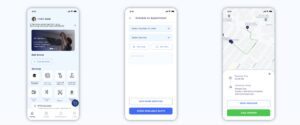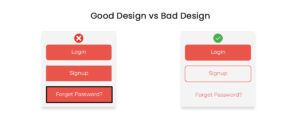
Understanding the Importance of User Interface Design in Mobile App Development
Mobile apps have become an integral part of everyday life for most people. We use apps for everything from communication, productivity, entertainment, shopping, banking, navigation, and more. There are now over 5 million apps available across iOS and Android app stores. With so many apps competing for user attention, having an intuitive and visually appealing user interface design is critical for an app’s success.
It directly impacts user adoption, engagement, conversions, and retention. Studies show that users form an opinion about an app’s credibility and ease-of-use within the first 50 milliseconds of viewing the interface.
Why User Interface Design is Critical for Mobile Apps

In this blog post, we will take a deeper look at why user interface design plays such a crucial role in mobile app development.
We will examine the various elements of User Interface design and how they influence the user experience.
We will also explore some best practices for designing effective interfaces for mobile, which requires accounting for smaller screens, touch inputs, and mobility.
Following proper User Interface conventions can make the difference between an app delighting users or frustrating them. With the competition in the mobile app marketplace, there is little room for poor or mediocre UI/UX design.
The Role of User Interface Design in Mobile Apps

This includes:
- The overall layout and structure of the app’s screens and pages. For example, where menus, buttons, icons are positioned.
- The visual design – colours, fonts, shapes, spacing used throughout the app. This establishes the look, feel and brand identity.
- Interactive elements like buttons, toggles, sliders that users tap/swipe/pinch/scroll.
- Navigational components like tab bars, side menus, bottom nav bars that facilitate moving between sections.
- Information hierarchy – how prominently different types of content are displayed.
- Transition animations between screens or when components appear/disappear.
The User Interface essentially acts as the bridge between the user and the functionality of the app. A well-designed User Interface makes this interaction intuitive, efficient and pleasurable. Whereas a poor User Interface introduces friction that frustrates users.
An effective User Interface design is crucial because it directly impacts how easy or difficult it is for users to complete tasks and achieve their goals within the app.
Good UI removes obstacles and confusion. Bad User Interface adds extra steps that annoy users.
Thoughtful UI design makes even complex tasks feel simple and straightforward. Users hardly notice the UI when it flows naturally.
But they will quickly notice UI pain points like hard to tap buttons, confusing menus and complicated workflows. These irritations lower engagement, increase abandonment and hurt conversions.
In summary, the UI design profoundly influences the user experience of a mobile app. It can make the difference between an app people love or an app they delete within minutes. So for mobile developers, getting the UI right should be a top priority.
Key Aspects of User Interface Design for Mobile

Responsive Design
- Mobile devices come in a wide range of screen sizes – from small phones to larger tablets. The UI needs to adapt and respond well to these different dimensions.
- Key elements like buttons, menus, text should resize and reflow based on the screen width.
- The layout should adjust smoothly for different orientations (portrait to landscape).
- Using relative units like %, vh, vw instead of fixed pixels enables flexibility.
- Responsive design ensures UI consistency and usability across devices.
Intuitive Navigation
- Menus, tabs, links must make navigational paths clear and predictable. Users should be able to easily find their way.
- Commonly used sections should be accessible with the least effort. Reduce clutter.
- Clearly label navigation elements. Use icons that quickly communicate meaning.
- Consistent placement of menus and CTAs aids learnability. Don’t make users relearn.
- Minimise user effort and confusion so they can focus on tasks rather than fighting the UI.
Touch Target Sizes
- Unlike mouse clicks, fingers are imprecise when tapping mobile screens. So tappable elements need sufficient padding.
- Recommended minimum touch target size is 48 CSS pixels. account for aspects like device type and context of use.
- Interactive elements like buttons, sliders, toggles should have enough whitespace around them for easy tapping.
- Avoid packing tappable elements too densely or making users tap multiple times to hit a small target.
Readability
- Smaller screens constrain how much text can be legibly displayed. Need to optimise font sizes, line spacing and contrast.
- Important text like headings and buttons should use larger font sizes optimised for quick mobile reading.
- Line lengths should not require heavy horizontal scrolling. Narrower columns improve readability.
- Strong visual contrast between text and background is important, especially for body copy.
Gestures
- Mobile users interact via touch gestures like tap, swipe, pinch, drag, long press. These need to drive expected actions.
- Give visual cues about which elements are tappable or swipeable.
- Provide clear feedback when users perform gestures, like screen transitions or element changes.
- Follow platform conventions – eg: swipe down to refresh, swipe right to delete.
Best Practices for Mobile User Interface Design

Simplify and Streamline
- Mobile screens are limited real estate. Every element should have purpose and enhance usability.
- Remove extraneous visuals, text, navigation that clutter the interface without value.
- Streamline workflows to minimise the number of steps users take to complete a task.
- Progressive disclosure shows more options only as needed rather than overwhelming users.
Visual Hierarchy
- Establish a clear visual hierarchy through size, colour, spacing that directs attention in order of importance.
- Related UI elements should be visually grouped together. Proximity builds relationships.
- Draw attention to primary actions you want users to take. Make secondary things secondary.
- Balance whitespace appropriately so the UI is organised but not sparse.
Iconography
- Icons simplify interfaces by representing functions, subjects, actions.
- Keep icons, imagery, and labels consistent across all parts of the app for familiarity.
- Use common icon types users recognize like arrows, settings cogwheels, help question marks.
- Test icons to ensure meaning is clear to users, not just designers.
Indicating Interactivity
- Provide visual cues like colour changes and micro animations to show which elements are interactive.
- Affordances like sliders, switches, buttons have inherent intractability users understand.
- Avoid false affordances that suggest invalid actions. Only make interactive what is truly tappable.
Feedback
- Always provide real-time feedback on user actions like screen changes, menu expands, etc.
- Use progress bars/indicators for longer processes so users understand system status.
- Well-timed microinteractions reassure users with their taps and gestures registered.
Platform Guidelines
- Follow established platform conventions for iOS, Android to leverage user familiarity.
- Adhere to human interface guidelines provided by Apple and Google.
- User testing on both platforms identifies platform-specific issues.
The Impact of Good and Bad User Interface Design

User Engagement & Satisfaction
- Well-designed interfaces with clear navigation, visual appeal, and seamless workflows lead to higher user engagement. Users are more likely to return and spend time in apps with good UI.
- Good UIs minimise user effort so people can focus on app tasks rather than fighting the interface. This leads to greater satisfaction.
- Frustrating UIs that are confusing, cluttered or full of irritations cause users to disengage. They feel discouraged from using the app.
Competitive Differentiation
- In a crowded app market, excellent UI/UX design is a competitive advantage that makes an app stand out.
- Users perceive apps with polished, cutting-edge interfaces as higher quality and more trustworthy.
- Buggy disjointed UI/UX reflects poorly on a brand, giving the impression that the app was not built thoughtfully.
Conversions & Desired Actions
- UI problems like confusing menus, hard to find options, and complicated workflows hurt conversion rates. Users cannot take desired actions.
- Well-designed conversion funnels and clearly marked calls-to-action improve conversion potential.
- Good UIs enhance findability of options and information. Bad UIs bury them too deep.
- Roadblocks during critical user journeys lead to failure to complete signups, purchases, content sharing, etc.
Conclusion
At Infin Mobile Solutions, our singular focus over the last 7+ years has been helping clients bring innovative mobile and web apps to life.
We are passionate about collaborating closely with our clients to deeply understand their needs and deliver solutions that are not just functional, but truly user-friendly.
Our expertise spans the full app development lifecycle – from ideation and UX design to development and launch. We leverage an agile approach so we can adapt quickly to evolving requirements.
But beyond just our technical skills, what sets us apart is our relentless commitment to creating delightful user experiences. Our design thinking helps us build interfaces and interactions that are intuitive and frictionless.
Performance is always top-of-mind as well, given the need for speed in today’s digital landscape.
If you’re seeking a partner to turn your app ideas into reality, we encourage you to get in touch. We offer a free consultation to understand your vision and explore how we can bring our expertise to bear.
Over the past 7+ years, we’ve found immense satisfaction in seeing our clients succeed. We look forward to doing the same for you on your mobile and web projects.
FAQs
What is mobile app UI design?
Mobile app UI design refers to the user interface and visual design of mobile apps. It includes the layouts, controls, transitions, system interfaces, and visual elements that users interact with. Good UI design enhances usability and the overall user experience.
UI design in mobile application development
UI design plays a critical role in mobile app development. Mobile UI design needs to account for smaller screens, touch inputs, and mobility compared to desktop sites. Following platform guidelines and best practices for elements like navigation and gestures creates intuitive mobile interfaces.
UI components in mobile application development
Some common mobile UI components include navigation menus, tabs, buttons, forms, lists, modals, icons, input fields, toggles, snackbars. Mobile UI components need to be responsive, have optimised target sizes, and support touch gestures.
Mobile app development UI design
Mobile app developers need to focus on crafting visually appealing, simple, consistent UI design. This includes information hierarchy, minimalist interfaces, effective use of colour, typography, spacing, and microinteractions. A seamless cross-platform UI/UX is key.
What is mobile app UI design?
Mobile app UI design refers to the visual layouts, controls, transitions, system interfaces and other elements that define the user experience of a mobile app. It determines how the app looks, functions and feels.
UI standards for mobile applications
Key UI standards for mobile apps include consistency, simplicity, user control, good navigation, feedback for actions, easy recoverability, aesthetic visuals, typography and icons optimised for mobile. Following platform guidelines for iOS and Android is important.
What is mobile app development?
Mobile app development is the process of creating software applications for mobile devices like smartphones and tablets. It involves ideation, UI/UX design, coding, testing and launching the app on app stores. Mobile apps can be built natively or with cross-platform frameworks.
User interface in mobile application development?
The user interface enables interaction between a mobile app and its users. Developing intuitive, responsive UI is crucial for mobile apps. This includes layouts, navigation, gestures, visuals and microinteractions optimised for mobile contexts.
What is mobile app UI design?
Mobile app UI design involves the visual interfaces, controls, transitions, layouts and interactive elements that define how a mobile app looks and functions. It focuses on crafting experiences optimised for mobile users.
UI standards for mobile applications
Standard guidelines for effective mobile UI include simplicity, consistency, clear navigation, feedback, optimised typography and iconography, strong information hierarchy. Leveraging platform conventions for iOS and Android is recommended.
What is mobile app development?
Mobile app development is the creation of software applications designed specifically for mobile devices and their constraints like smaller screens and touch inputs. It involves ideation, UI/UX design, coding, testing and ultimately launching on app stores.
Really superb information can be found on site.Blog monry